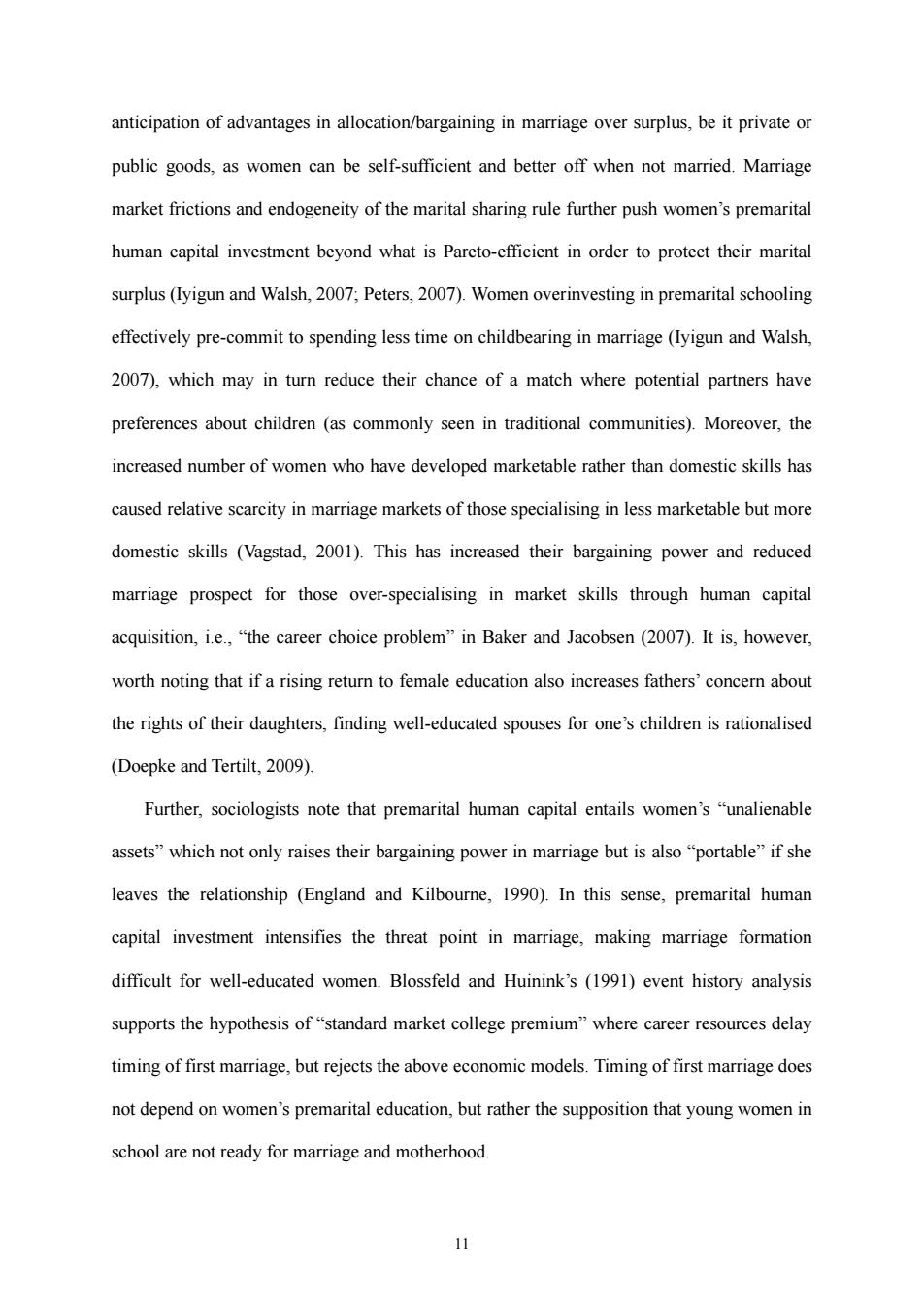
anticipation of advantages in allocation/bargaining in marriage over surplus,be it private or public goods,as women can be self-sufficient and better off when not married.Marriage market frictions and endogeneity of the marital sharing rule further push women's premarital human capital investment beyond what is Pareto-efficient in order to protect their marital surplus(Iyigun and Walsh,2007;Peters,2007).Women overinvesting in premarital schooling effectively pre-commit to spending less time on childbearing in marriage(Iyigun and Walsh, 2007),which may in turn reduce their chance of a match where potential partners have preferences about children (as commonly seen in traditional communities).Moreover,the increased number of women who have developed marketable rather than domestic skills has caused relative scarcity in marriage markets of those specialising in less marketable but more domestic skills (Vagstad,2001).This has increased their bargaining power and reduced marriage prospect for those over-specialising in market skills through human capital acquisition,i.e.,"the career choice problem"in Baker and Jacobsen(2007).It is,however, worth noting that if a rising return to female education also increases fathers'concern about the rights of their daughters,finding well-educated spouses for one's children is rationalised (Doepke and Tertilt,2009). Further,sociologists note that premarital human capital entails women's "unalienable assets"which not only raises their bargaining power in marriage but is also"portable"if she leaves the relationship (England and Kilbourne,1990).In this sense,premarital human capital investment intensifies the threat point in marriage,making marriage formation difficult for well-educated women.Blossfeld and Huinink's (1991)event history analysis supports the hypothesis of"standard market college premium"where career resources delay timing of first marriage,but rejects the above economic models.Timing of first marriage does not depend on women's premarital education,but rather the supposition that young women in school are not ready for marriage and motherhood. 11
11 anticipation of advantages in allocation/bargaining in marriage over surplus, be it private or public goods, as women can be self-sufficient and better off when not married. Marriage market frictions and endogeneity of the marital sharing rule further push women’s premarital human capital investment beyond what is Pareto-efficient in order to protect their marital surplus (Iyigun and Walsh, 2007; Peters, 2007). Women overinvesting in premarital schooling effectively pre-commit to spending less time on childbearing in marriage (Iyigun and Walsh, 2007), which may in turn reduce their chance of a match where potential partners have preferences about children (as commonly seen in traditional communities). Moreover, the increased number of women who have developed marketable rather than domestic skills has caused relative scarcity in marriage markets of those specialising in less marketable but more domestic skills (Vagstad, 2001). This has increased their bargaining power and reduced marriage prospect for those over-specialising in market skills through human capital acquisition, i.e., “the career choice problem” in Baker and Jacobsen (2007). It is, however, worth noting that if a rising return to female education also increases fathers’ concern about the rights of their daughters, finding well-educated spouses for one’s children is rationalised (Doepke and Tertilt, 2009). Further, sociologists note that premarital human capital entails women’s “unalienable assets” which not only raises their bargaining power in marriage but is also “portable” if she leaves the relationship (England and Kilbourne, 1990). In this sense, premarital human capital investment intensifies the threat point in marriage, making marriage formation difficult for well-educated women. Blossfeld and Huinink’s (1991) event history analysis supports the hypothesis of “standard market college premium” where career resources delay timing of first marriage, but rejects the above economic models. Timing of first marriage does not depend on women’s premarital education, but rather the supposition that young women in school are not ready for marriage and motherhood
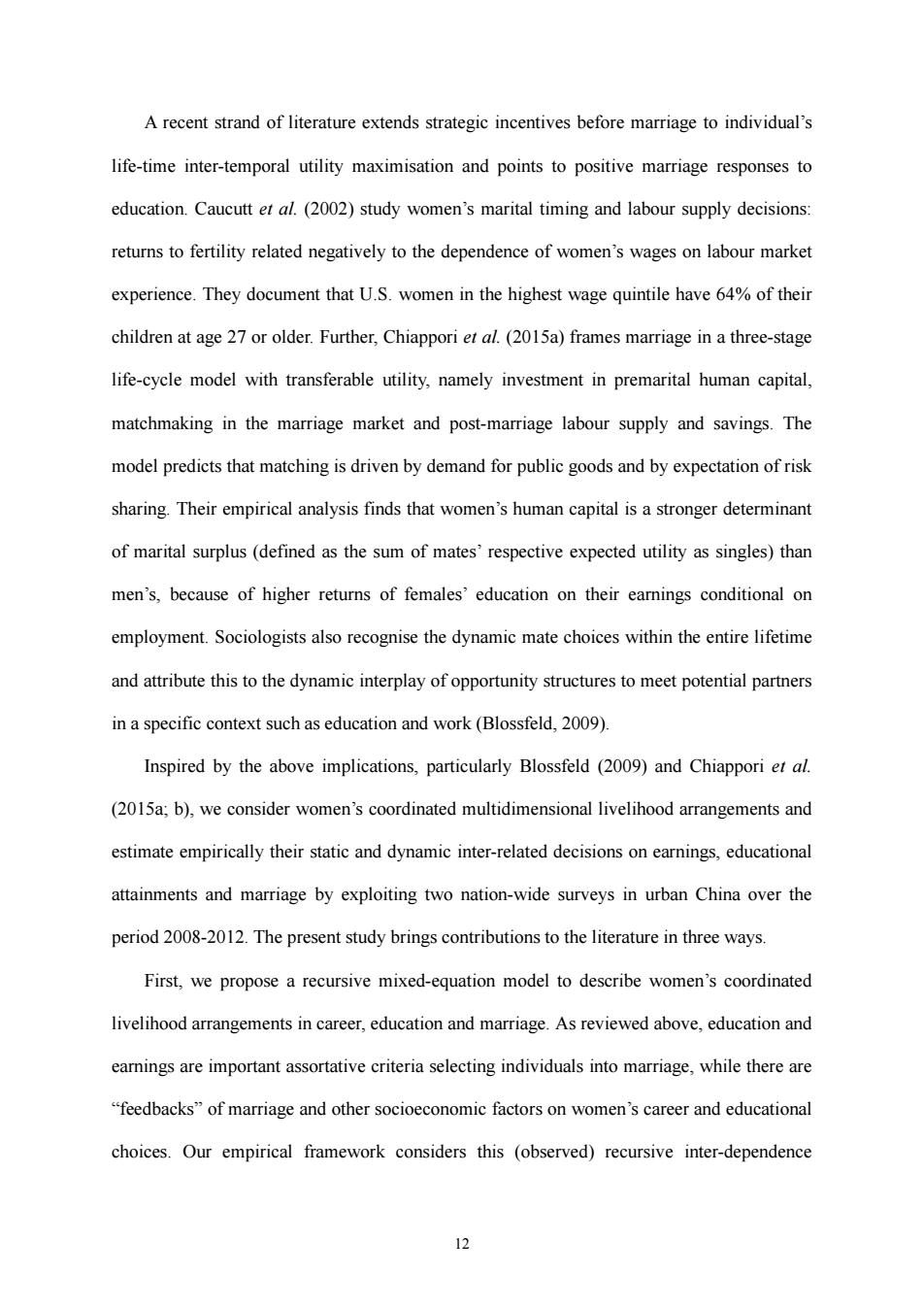
A recent strand of literature extends strategic incentives before marriage to individual's life-time inter-temporal utility maximisation and points to positive marriage responses to education.Caucutt et al.(2002)study women's marital timing and labour supply decisions: returns to fertility related negatively to the dependence of women's wages on labour market experience.They document that U.S.women in the highest wage quintile have 64%of their children at age 27 or older.Further,Chiappori et al.(2015a)frames marriage in a three-stage life-cycle model with transferable utility,namely investment in premarital human capital, matchmaking in the marriage market and post-marriage labour supply and savings.The model predicts that matching is driven by demand for public goods and by expectation of risk sharing.Their empirical analysis finds that women's human capital is a stronger determinant of marital surplus(defined as the sum of mates'respective expected utility as singles)than men's,because of higher returns of females'education on their earnings conditional on employment.Sociologists also recognise the dynamic mate choices within the entire lifetime and attribute this to the dynamic interplay of opportunity structures to meet potential partners in a specific context such as education and work(Blossfeld,2009). Inspired by the above implications,particularly Blossfeld (2009)and Chiappori et al. (2015a;b),we consider women's coordinated multidimensional livelihood arrangements and estimate empirically their static and dynamic inter-related decisions on earnings,educational attainments and marriage by exploiting two nation-wide surveys in urban China over the period 2008-2012.The present study brings contributions to the literature in three ways. First,we propose a recursive mixed-equation model to describe women's coordinated livelihood arrangements in career,education and marriage.As reviewed above,education and earnings are important assortative criteria selecting individuals into marriage,while there are "feedbacks"of marriage and other socioeconomic factors on women's career and educational choices.Our empirical framework considers this (observed)recursive inter-dependence 12
12 A recent strand of literature extends strategic incentives before marriage to individual’s life-time inter-temporal utility maximisation and points to positive marriage responses to education. Caucutt et al. (2002) study women’s marital timing and labour supply decisions: returns to fertility related negatively to the dependence of women’s wages on labour market experience. They document that U.S. women in the highest wage quintile have 64% of their children at age 27 or older. Further, Chiappori et al. (2015a) frames marriage in a three-stage life-cycle model with transferable utility, namely investment in premarital human capital, matchmaking in the marriage market and post-marriage labour supply and savings. The model predicts that matching is driven by demand for public goods and by expectation of risk sharing. Their empirical analysis finds that women’s human capital is a stronger determinant of marital surplus (defined as the sum of mates’ respective expected utility as singles) than men’s, because of higher returns of females’ education on their earnings conditional on employment. Sociologists also recognise the dynamic mate choices within the entire lifetime and attribute this to the dynamic interplay of opportunity structures to meet potential partners in a specific context such as education and work (Blossfeld, 2009). Inspired by the above implications, particularly Blossfeld (2009) and Chiappori et al. (2015a; b), we consider women’s coordinated multidimensional livelihood arrangements and estimate empirically their static and dynamic inter-related decisions on earnings, educational attainments and marriage by exploiting two nation-wide surveys in urban China over the period 2008-2012. The present study brings contributions to the literature in three ways. First, we propose a recursive mixed-equation model to describe women’s coordinated livelihood arrangements in career, education and marriage. As reviewed above, education and earnings are important assortative criteria selecting individuals into marriage, while there are “feedbacks” of marriage and other socioeconomic factors on women’s career and educational choices. Our empirical framework considers this (observed) recursive inter-dependence
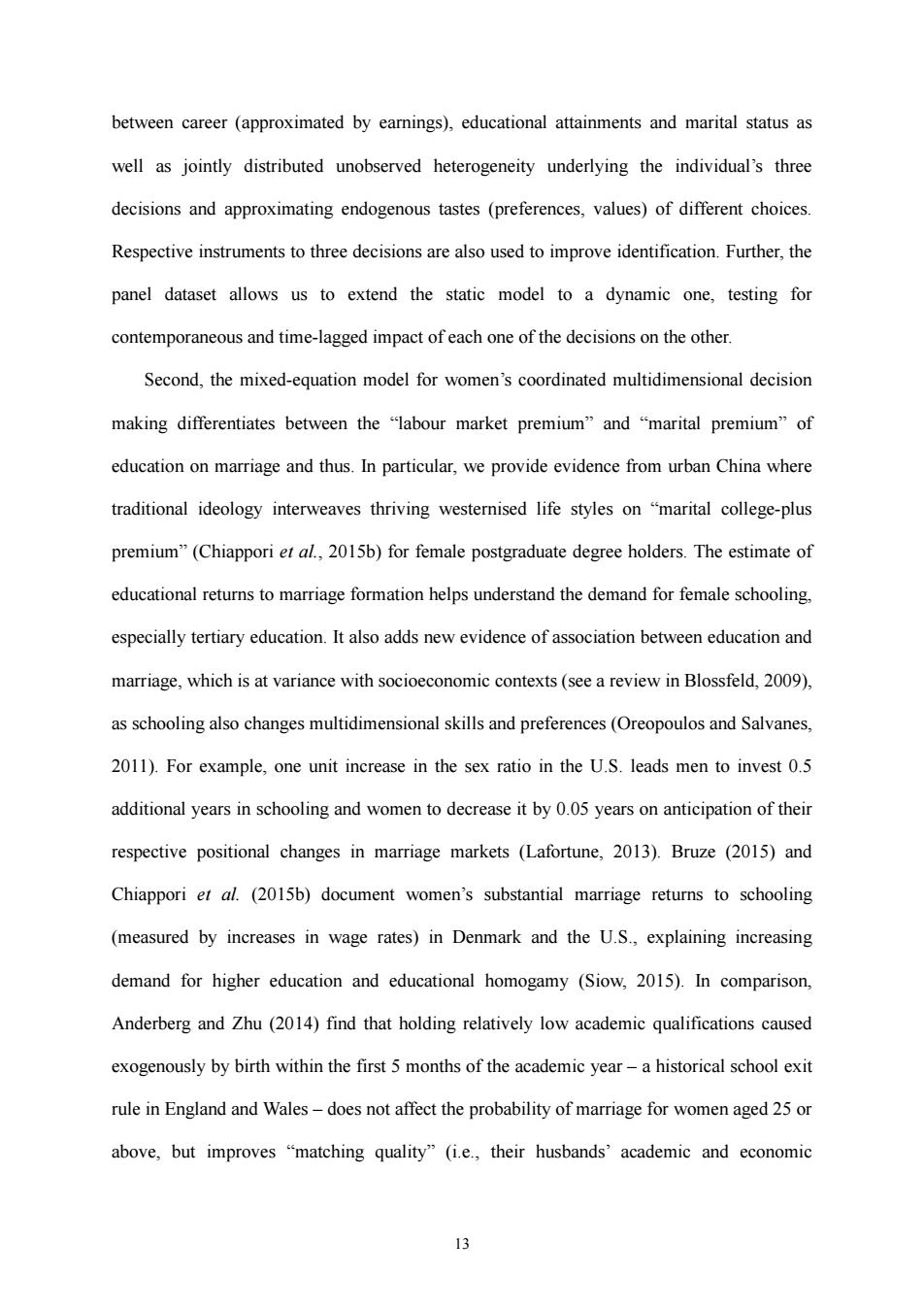
between career (approximated by earnings),educational attainments and marital status as well as jointly distributed unobserved heterogeneity underlying the individual's three decisions and approximating endogenous tastes (preferences,values)of different choices. Respective instruments to three decisions are also used to improve identification.Further,the panel dataset allows us to extend the static model to a dynamic one,testing for contemporaneous and time-lagged impact of each one of the decisions on the other. Second,the mixed-equation model for women's coordinated multidimensional decision making differentiates between the“labour market premium”and“marital premium”of education on marriage and thus.In particular,we provide evidence from urban China where traditional ideology interweaves thriving westernised life styles on "marital college-plus premium"(Chiappori et al.,2015b)for female postgraduate degree holders.The estimate of educational returns to marriage formation helps understand the demand for female schooling, especially tertiary education.It also adds new evidence of association between education and marriage,which is at variance with socioeconomic contexts(see a review in Blossfeld,2009), as schooling also changes multidimensional skills and preferences(Oreopoulos and Salvanes, 2011).For example,one unit increase in the sex ratio in the U.S.leads men to invest 0.5 additional years in schooling and women to decrease it by 0.05 years on anticipation of their respective positional changes in marriage markets (Lafortune,2013).Bruze (2015)and Chiappori et al.(2015b)document women's substantial marriage returns to schooling (measured by increases in wage rates)in Denmark and the U.S.,explaining increasing demand for higher education and educational homogamy (Siow,2015).In comparison, Anderberg and Zhu (2014)find that holding relatively low academic qualifications caused exogenously by birth within the first 5 months of the academic year-a historical school exit rule in England and Wales-does not affect the probability of marriage for women aged 25 or above,but improves "matching quality"(i.e.,their husbands'academic and economic 13
13 between career (approximated by earnings), educational attainments and marital status as well as jointly distributed unobserved heterogeneity underlying the individual’s three decisions and approximating endogenous tastes (preferences, values) of different choices. Respective instruments to three decisions are also used to improve identification. Further, the panel dataset allows us to extend the static model to a dynamic one, testing for contemporaneous and time-lagged impact of each one of the decisions on the other. Second, the mixed-equation model for women’s coordinated multidimensional decision making differentiates between the “labour market premium” and “marital premium” of education on marriage and thus. In particular, we provide evidence from urban China where traditional ideology interweaves thriving westernised life styles on “marital college-plus premium” (Chiappori et al., 2015b) for female postgraduate degree holders. The estimate of educational returns to marriage formation helps understand the demand for female schooling, especially tertiary education. It also adds new evidence of association between education and marriage, which is at variance with socioeconomic contexts (see a review in Blossfeld, 2009), as schooling also changes multidimensional skills and preferences (Oreopoulos and Salvanes, 2011). For example, one unit increase in the sex ratio in the U.S. leads men to invest 0.5 additional years in schooling and women to decrease it by 0.05 years on anticipation of their respective positional changes in marriage markets (Lafortune, 2013). Bruze (2015) and Chiappori et al. (2015b) document women’s substantial marriage returns to schooling (measured by increases in wage rates) in Denmark and the U.S., explaining increasing demand for higher education and educational homogamy (Siow, 2015). In comparison, Anderberg and Zhu (2014) find that holding relatively low academic qualifications caused exogenously by birth within the first 5 months of the academic year – a historical school exit rule in England and Wales – does not affect the probability of marriage for women aged 25 or above, but improves “matching quality” (i.e., their husbands’ academic and economic
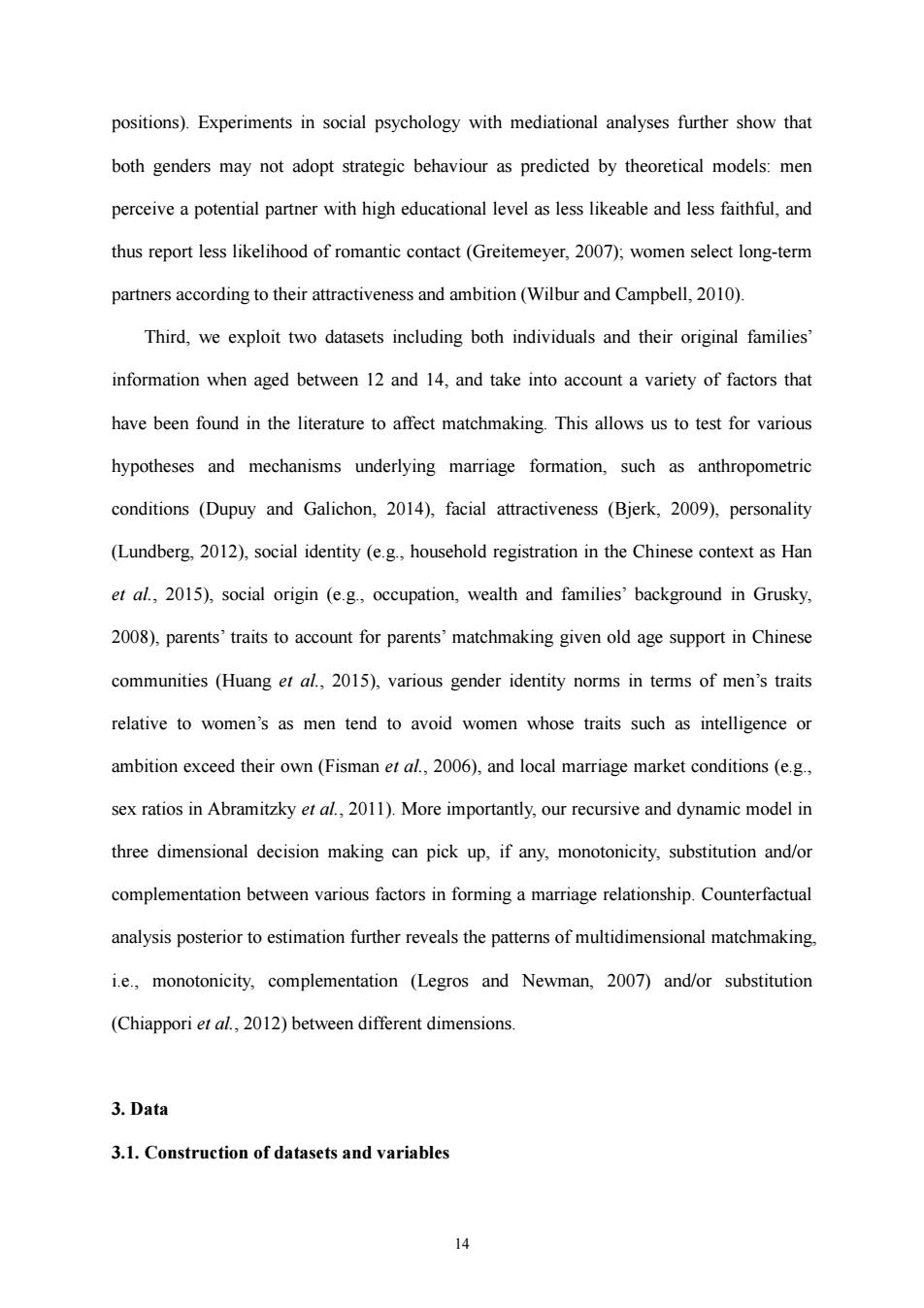
positions).Experiments in social psychology with mediational analyses further show that both genders may not adopt strategic behaviour as predicted by theoretical models:men perceive a potential partner with high educational level as less likeable and less faithful,and thus report less likelihood of romantic contact(Greitemeyer,2007);women select long-term partners according to their attractiveness and ambition (Wilbur and Campbell,2010) Third,we exploit two datasets including both individuals and their original families' information when aged between 12 and 14,and take into account a variety of factors that have been found in the literature to affect matchmaking.This allows us to test for various hypotheses and mechanisms underlying marriage formation,such as anthropometric conditions (Dupuy and Galichon,2014),facial attractiveness (Bjerk,2009),personality (Lundberg,2012),social identity (e.g.,household registration in the Chinese context as Han et al.,2015),social origin (e.g.,occupation,wealth and families'background in Grusky, 2008),parents'traits to account for parents'matchmaking given old age support in Chinese communities (Huang et al.,2015),various gender identity norms in terms of men's traits relative to women's as men tend to avoid women whose traits such as intelligence or ambition exceed their own(Fisman et al.,2006),and local marriage market conditions (e.g., sex ratios in Abramitzky et al.,2011).More importantly,our recursive and dynamic model in three dimensional decision making can pick up,if any,monotonicity,substitution and/or complementation between various factors in forming a marriage relationship.Counterfactual analysis posterior to estimation further reveals the patterns of multidimensional matchmaking, i.e.,monotonicity,complementation (Legros and Newman,2007)and/or substitution (Chiappori et al.,2012)between different dimensions. 3.Data 3.1.Construction of datasets and variables 14
14 positions). Experiments in social psychology with mediational analyses further show that both genders may not adopt strategic behaviour as predicted by theoretical models: men perceive a potential partner with high educational level as less likeable and less faithful, and thus report less likelihood of romantic contact (Greitemeyer, 2007); women select long-term partners according to their attractiveness and ambition (Wilbur and Campbell, 2010). Third, we exploit two datasets including both individuals and their original families’ information when aged between 12 and 14, and take into account a variety of factors that have been found in the literature to affect matchmaking. This allows us to test for various hypotheses and mechanisms underlying marriage formation, such as anthropometric conditions (Dupuy and Galichon, 2014), facial attractiveness (Bjerk, 2009), personality (Lundberg, 2012), social identity (e.g., household registration in the Chinese context as Han et al., 2015), social origin (e.g., occupation, wealth and families’ background in Grusky, 2008), parents’ traits to account for parents’ matchmaking given old age support in Chinese communities (Huang et al., 2015), various gender identity norms in terms of men’s traits relative to women’s as men tend to avoid women whose traits such as intelligence or ambition exceed their own (Fisman et al., 2006), and local marriage market conditions (e.g., sex ratios in Abramitzky et al., 2011). More importantly, our recursive and dynamic model in three dimensional decision making can pick up, if any, monotonicity, substitution and/or complementation between various factors in forming a marriage relationship. Counterfactual analysis posterior to estimation further reveals the patterns of multidimensional matchmaking, i.e., monotonicity, complementation (Legros and Newman, 2007) and/or substitution (Chiappori et al., 2012) between different dimensions. 3. Data 3.1. Construction of datasets and variables
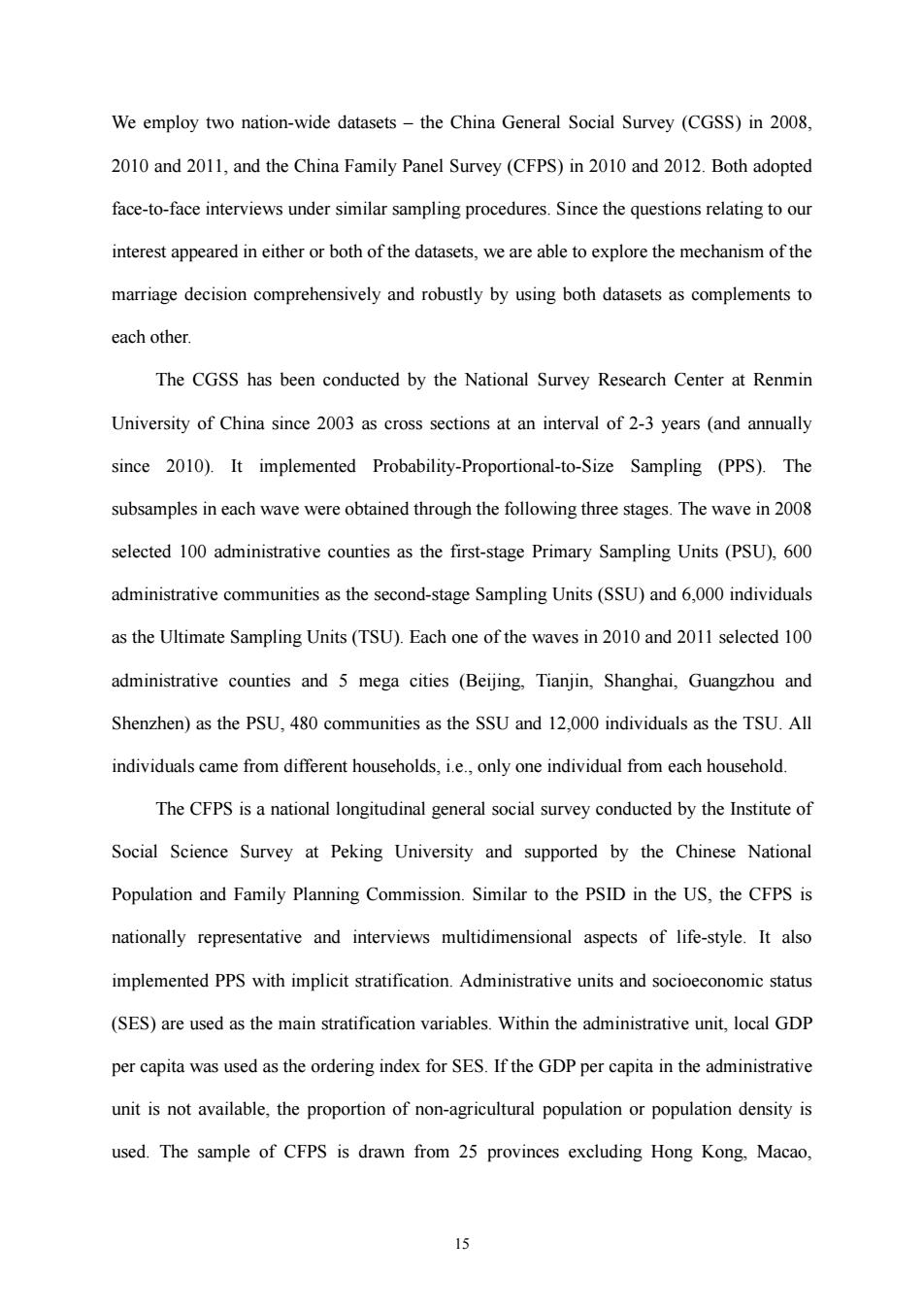
We employ two nation-wide datasets-the China General Social Survey (CGSS)in 2008, 2010 and 2011,and the China Family Panel Survey (CFPS)in 2010 and 2012.Both adopted face-to-face interviews under similar sampling procedures.Since the questions relating to our interest appeared in either or both of the datasets,we are able to explore the mechanism of the marriage decision comprehensively and robustly by using both datasets as complements to each other. The CGSS has been conducted by the National Survey Research Center at Renmin University of China since 2003 as cross sections at an interval of 2-3 years (and annually since 2010).It implemented Probability-Proportional-to-Size Sampling (PPS).The subsamples in each wave were obtained through the following three stages.The wave in 2008 selected 100 administrative counties as the first-stage Primary Sampling Units(PSU),600 administrative communities as the second-stage Sampling Units(SSU)and 6,000 individuals as the Ultimate Sampling Units(TSU).Each one of the waves in 2010 and 2011 selected 100 administrative counties and 5 mega cities (Beijing,Tianjin,Shanghai,Guangzhou and Shenzhen)as the PSU,480 communities as the SSU and 12,000 individuals as the TSU.All individuals came from different households,i.e.,only one individual from each household. The CFPS is a national longitudinal general social survey conducted by the Institute of Social Science Survey at Peking University and supported by the Chinese National Population and Family Planning Commission.Similar to the PSID in the US,the CFPS is nationally representative and interviews multidimensional aspects of life-style.It also implemented PPS with implicit stratification.Administrative units and socioeconomic status (SES)are used as the main stratification variables.Within the administrative unit,local GDP per capita was used as the ordering index for SES.If the GDP per capita in the administrative unit is not available,the proportion of non-agricultural population or population density is used.The sample of CFPS is drawn from 25 provinces excluding Hong Kong,Macao, 15
15 We employ two nation-wide datasets – the China General Social Survey (CGSS) in 2008, 2010 and 2011, and the China Family Panel Survey (CFPS) in 2010 and 2012. Both adopted face-to-face interviews under similar sampling procedures. Since the questions relating to our interest appeared in either or both of the datasets, we are able to explore the mechanism of the marriage decision comprehensively and robustly by using both datasets as complements to each other. The CGSS has been conducted by the National Survey Research Center at Renmin University of China since 2003 as cross sections at an interval of 2-3 years (and annually since 2010). It implemented Probability-Proportional-to-Size Sampling (PPS). The subsamples in each wave were obtained through the following three stages. The wave in 2008 selected 100 administrative counties as the first-stage Primary Sampling Units (PSU), 600 administrative communities as the second-stage Sampling Units (SSU) and 6,000 individuals as the Ultimate Sampling Units (TSU). Each one of the waves in 2010 and 2011 selected 100 administrative counties and 5 mega cities (Beijing, Tianjin, Shanghai, Guangzhou and Shenzhen) as the PSU, 480 communities as the SSU and 12,000 individuals as the TSU. All individuals came from different households, i.e., only one individual from each household. The CFPS is a national longitudinal general social survey conducted by the Institute of Social Science Survey at Peking University and supported by the Chinese National Population and Family Planning Commission. Similar to the PSID in the US, the CFPS is nationally representative and interviews multidimensional aspects of life-style. It also implemented PPS with implicit stratification. Administrative units and socioeconomic status (SES) are used as the main stratification variables. Within the administrative unit, local GDP per capita was used as the ordering index for SES. If the GDP per capita in the administrative unit is not available, the proportion of non-agricultural population or population density is used. The sample of CFPS is drawn from 25 provinces excluding Hong Kong, Macao